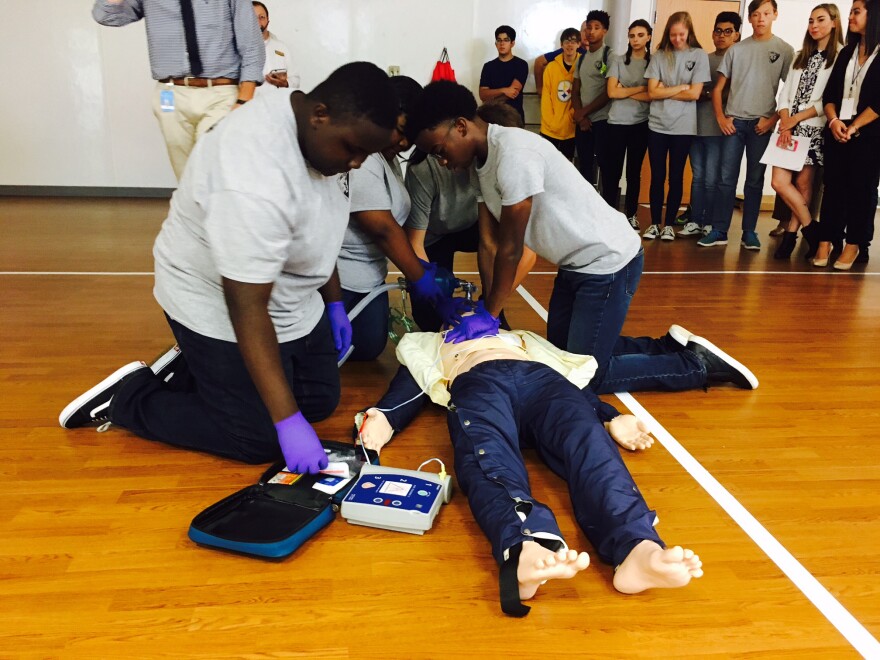A team of EMS students works to resuscitate a full-size dummy that is going into cardiac arrest in a high school gym. The first responders are 16 year-old juniors at North Wake College & Career Academy, and this is just the beginning of their careers.
Paramedic students from Wake Tech Community College rush in to finish the job, and the high school students move over and watch intently from the side.
"Oh my gosh, that’s so cool, I want to be just like them," says Emerson Bulluck, a junior at North Wake College And Career Academy. "I hope by the end of my senior year, when I get my EMT certificate, I can do that."

Emerson is a new student at North Wake College and Career Academy. Everyone is. The school opened this fall, with freshmen, sophomores and juniors in five career tracks. Alexis Fox is also a junior who left her previous high school to come here.
"It was hard to leave," said Alexis, who expects to be in the school's first graduating class in 2019. "I miss my friends, but, I know I want to be an obstetrician and gynecologist, so I know this will give me a good foundation to one day being able to do that."
Alexis plans to work as an EMT to help pay her way through college, and her high school will prepare her to do that.
This is a Cooperative Innovative High School, a public school where qualified students can earn dual credit toward their high school diploma, while taking community college courses. At North Wake, students can study culinary arts, early childhood education, hospitality management, IT or EMS. There are 125 of these schools in North Carolina, and each is capped at 100 students per grade. The schools are made possible by legislation passed in 2011 called the Career & College Promise.
Cooperative Innovative High Schools target at least one of the following types of students: those at risk of not finishing high school, those who would be the first generation in their family to attend college and/or students who would benefit from accelerated programming.
Emerson and Alexis are both on the EMS track. Their instructor Jake Hardison says they'll graduate high school not only with a diploma, but also with an EMT license and 17 credit hours – essentially a whole semester of college.

"They’re going to walk out with a direct connection to one of the number one employers, one of the number one EMS systems in the country," Hardison said.
Wake County EMS is nationally known in its industry for its cardiac arrest survival rate and for developing new protocols.
Even though it’s one of the best, Wake County EMS has a shortage of paramedics. When the new school was in its planning stages, a committee of administrators looked at local workforce data to determine which tracks to offer.
Paul Domenico is the Director of Curriculum Enhancement Programs at Wake County Schools and served on that committee.
"We look for job growth, opportunities for the jobs to be out there for the kids once they graduate," Domenico said. "We also look at wage earnings. Then the third thing we look for is, especially in this case with partnering with Wake Tech Community College, is that there's a career pathway that’s offered there."

There are close ties between the school and Wake Tech. The community college instructors come right into the classrooms. And the local EMS system is also involved. The students will do summer internships with Wake County EMS.
"They’ll ride along with district chiefs on quick response vehicles with Wake County EMS just to get their feet on the ground and get some real world experience," EMS instructor Hardison explained.
Hardison’s an employee of Wake Tech and a practicing paramedic at Wake County EMS. He first met Ermerson Bulluck at Wake County EMS club, an initiative started by Wake County EMS to grab the interest of local high schoolers. Now he is one of Emerson's high school teachers.
Hardison turned up a promotion to his once dream job as a specialized community paramedic to teach at this high school. He says the local EMS officials hope the school will develop a new generation of EMTs from the area to fill the shortage in the industry.
“And that’s a balance because, you want to definitely fulfill that employee gap, but at the same time, you don’t want to steer these kids on a different path from what they have potential for," Hardison said. "You know, it's saying, 'Hey, this is something you can do, just keep this career in mind.' ”
Hardison had EMS in mind since he was a little kid. He got his EMT license as a teen, but had to study for it on top of school and sports. Then he earned a four-year degree in finance. While he went to college, Hardison also went to night school to become a paramedic. His students’ education looks much more streamlined.
“Oh, I’m jealous," Hardison said. "Like if this would’ve been around when I was in high school, I would’ve been all over this.”
Now he’s helping his students find paths to their own dream jobs.









